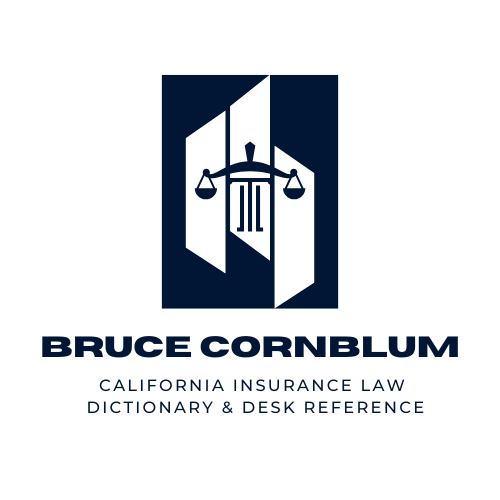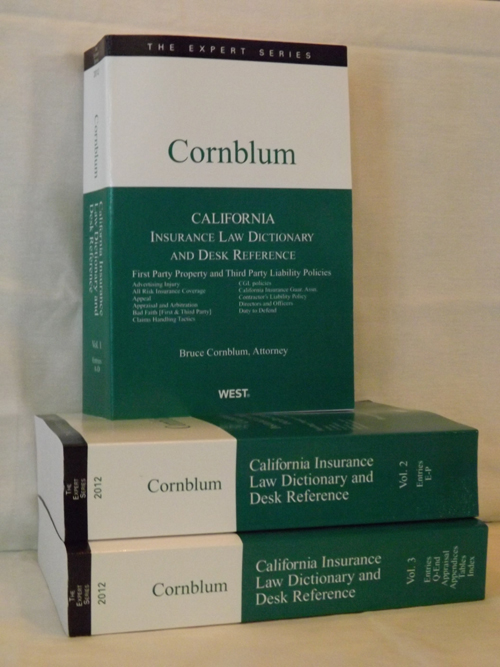In general
An insured may be sued by a third party claimant at a time when the law created a potential of liability under the policy. See § P67 POTENTIAL LIABILITY UNDER THE POLICY—DUTY TO DEFEND. The insured tenders to the insurer who agrees to defend the insured under a reservation of rights. Thereafter, pending resolution of the suit, a change in the law occurs by a ruling of the California Supreme Court which disapproves of decisions that supported a potential liability under the policy. After the change in the law occurred, the insurer withdraws its defense and refuses to pay defense fees for costs incurred before the ruling in the Supreme Court. What result?
Denial of coverage; existing appellate decisions are ‘unsettled’ at the time of denial; no bad faith
Where case law is ‘unsettled’ when the insurer first denies coverage, the ‘unsettledness’ does not create a potential for a covered claim. If an insurance company’s denial of coverage is reasonable, as shown by substantial case law in favor of its position, there can be no bad faith even though the insurance company’s position is ‘later’ rejected by the California Supreme Court. [Griffin Dewatering Corp. v. Northern Ins. Co. of New York, 176 Cal. App. 4th 172, 179–180, 97 Cal. Rptr. 3d 568 (4th Dist. 2009)] In Griffin, the insured was a sewage disposal plant. Water was discharged from the plant and damaged a home. The insured plant was sued. The insurer denied coverage and a defense. Uncertainty regarding the meaning of the absolute pollution exclusion existed. The question was, did the insurer’s total pollution exclusion categorically eliminate any potential for coverage for sewage backup? The trial court ruled that the insurer was ‘objectively erroneous’ in denying a defense. The Supreme Court issued during the pendency of the litigation its opinion in MacKinnon v. Truck Ins. Exchange, 31 Cal. 4th 635, 3 Cal. Rptr. 3d 228, 73 P.3d 1205 (2003). The MacKinnon opinion revealed numerous appellate decisions in California and in the United States that differed on the issue of the application of the absolute pollution exclusion. [Griffin, supra, at 176 Cal.App.4th 189–200] The court in Griffin reversed the substantial bad faith and punitive damage judgment in favor of the insured. See § I73 INTERPRETATION OF LAW [§ I73:3]; § B2 BAD FAITH LAWSUIT—FIRST PARTY [§ B2:4.1.1].
Where the potential of coverage turns on a legal question
Where the only potential for coverage under a liability policy turns on a legal question, the court must apply the present law, not the law that existed at the time the suit was filed. [Tamrac, Inc. v. California Ins. Guarantee Ass’n, 63 Cal. App. 4th 751, 758, 74 Cal. Rptr. 2d 338, 342 (2d Dist. 1998)] The affect of this rule is that there never was a potential for coverage, and hence there never was a duty to defend and/or indemnify. [Tamrac, Inc. v. California Ins. Guarantee Ass’n, 63 Cal. App. 4th 751, 758, 74 Cal. Rptr. 2d 338, 342 (2d Dist. 1998)] The fact that the underlying case was over is irrelevant. Insurance coverage and the costs and duties of defense are not issues that would be determined in the underlying case. If the insurer adequately reserves its rights at the time of accepting the defense, the dispute between the insured and the insurer can be determined after the underlying suit is finished. [Tamrac, Inc. v. California Ins. Guarantee Ass’n, 63 Cal. App. 4th 751, 758, 74 Cal. Rptr. 2d 338, 343 (2d Dist. 1998)] See § C112 CONTROLLING LEGAL AUTHORITY FROM APPELLATE COURTS; § A77 APPEAL [§ A77:22 Retroactivity of appellate decisions]; see also § S82 STATUTORY LIABILITY CREATED AFTER POLICY IS ISSUED.
Unsettled law concerning insurer’s policy; options of insurer
An insurer facing unsettled law (for example, whether the advertising coverage under Coverage B applies when the insured is soliciting plaintiff’s customer list) concerning its policys’ potential coverage of the third party’s claims has the following options with regards to the duty to defend:
1. Deny coverage [see § D25 DENIAL OF COVERAGE]; See also SEMX Corp. v. Federal Ins. Co., 398 F. Supp. 2d 1103 (S.D. Cal. 2005) (denial of coverage pre-MacKinnon v. Truck Ins.; subsequent to MacKinnon, court found coverage for one-time ammonia gas discharge). See § P64 POLLUTION.
There is no duty to defend where the only potential for liability turns on resolution of a legal question. [Golden Eagle Ins. Corp. v. Cen-Fed, Ltd., 148 Cal. App. 4th 976, 993, 56 Cal. Rptr. 3d 279 (2d Dist. 2007)] This rule assumes that there never existed a requirement that the court make a determination of one or more disputed factual issues upon which, if decided favorably in favor of the insured, would have established a potential liability under the policy. [Golden Eagle Ins. Corp. v. Cen-Fed, Ltd., 148 Cal. App. 4th 976, 993, 56 Cal. Rptr. 3d 279 (2d Dist. 2007)] If a disputed factual issue exists at the time the third party complaint is served on the insured, the insurer would be required to provide a defense at least until the facts were conclusively decided to show that there existed no coverage and thus no duty to defend. [Montrose Chemical Corp. v. Superior Court, 6 Cal. 4th 287, 299, 24 Cal. Rptr. 2d 467, 861 P.2d 1153 (1993)] See § P67 POTENTIAL LIABILITY UNDER POLICY [§ P67:14.1 Unsettled law.
2. Grant to the insured a defense under a reservation of rights with the understanding that reimbursement will be sought if it is later established, as a matter of law, that no duty to defend ever arose. [Scottsdale Ins. Co. v. MV Transp., 36 Cal. 4th 643, 660, 31 Cal. Rptr. 3d 147, 115 P.3d 460 (2005)];
3. If the insurer under a CGL policy properly reserves its rights, it may advance sums to defend its insured against a third party lawsuit and may thereafter recoup such costs from the insured if it is determined as a matter of law no duty to defend ever arose because the third party suit never suggested the possibility of a covered claim. [Scottsdale Ins. Co. v. MV Transp., 36 Cal. 4th 643, 662, 31 Cal. Rptr. 3d 147, 115 P.3d 460 (2005)]. See § C137 COVERAGE; § R58 RESERVATION OF RIGHTS
ILLUSTRATION: Trial court rules that a “potential liability” existed and the insurer must defend. The appellate court reverses the trial court finding no potential liability existed under the policy. Under this circumstance the entire defense fees and costs are reimbursable to the insurer. [Scottsdale Ins. Co. v. MV Transp., 36 Cal. 4th 643, 31 Cal. Rptr. 3d 147, 115 P.3d 460 (2005)]
ILLUSTRATION: A court of appeal finds a “potential liability” exists for coverage under the policy. However, the Court of Appeal is reversed by the Supreme Court that disagrees with the Court of Appeal. Under this circumstance the insured owes the insurer full reimbursement of all fees and costs. [Scottsdale Ins. Co. v. MV Transp., 36 Cal. 4th 643, 652, 31 Cal. Rptr. 3d 147, 115 P.3d 460 (2005)]
ILLUSTRATION: The underlying case was over in the trial court when the law changed. If the insurer properly reserved its rights and the case was not final, all fees and costs were reimbursable to the insurer. [Tamrac, Inc. v. California Ins. Guarantee Ass’n, 63 Cal. App. 4th 751, 758, 74 Cal. Rptr. 2d 338 (2d Dist. 1998)]
Reconsideration of a prior ruling is a proper procedure when there is a change in the law [Code of Civil Procedure § 1008]
Code of Civil Procedure § 1008(b) provides that: “A party who originally made an application for an order which was refused in whole or in part, or granted conditionally or on terms, may make a subsequent application for the same order upon new or different facts, circumstances or law … .” Code of Civil Procedure § 1008(c) provides that a court may at any time determine that there has been a change in a law that warrants it to reconsider a prior order. It may do so on its own motion and enter a different order. [Code of Civil Procedure § 1008(c)]
The application for reconsideration is not limited to the 10 day rule set forth in Code of Civil Procedure § 1008(a). The application for reconsideration may be made months after the court’s original order. [Malek v. Blue Cross of California, 121 Cal. App. 4th 44, 16 Cal. Rptr. 3d 687 (2d Dist. 2004)] In Malek, 121 Cal. App. 4th 44, 53–54, 16 Cal. Rptr. 3d 687, 693–694 the plaintiff’s suit was stayed upon motion by the insurer to compel arbitration under a health policy. The insurer’s motion was made April 1, 2002. In October 2002, plaintiffs moved to vacate the order compelling arbitration based upon a change in the law relating to the lawfulness of the arbitration provision in the health policy. The motion for reconsideration was denied. In March 2003 the court on its own motion set an order to show cause pursuant to Code of Civil Procedure § 1008(c), based upon a new decision that the court perceived to be a “change in the law.” [Malek, 121 Cal. App. 4th 44, 54] This was held to be proper. [Malek v. Blue Cross of California, 121 Cal. App. 4th 44, 59–60, 16 Cal. Rptr. 3d 687 (2d Dist. 2004)]
ILLUSTRATION: Trial court order granted a defense; in a separate unrelated suit the Supreme Court ruled on the same issue; reconsideration granted. In Lockheed Corp. v. Continental Ins. Co., 134 Cal. App. 4th 187, 198, 35 Cal. Rptr. 3d 799 (6th Dist. 2005), the insured moved for summary adjudication requesting the insurer defend the insured in an action before an administrative agency. The trial court, prior to 2001, granted the insured’s motion. In 2001 while the litigation was still pending, the Supreme Court decided Certain Underwriters at Lloyd’s of London v. Superior Court, 24 Cal. 4th 945, 103 Cal. Rptr. 2d 672, 16 P.3d 94 (2001). Based upon the Supreme Court decision, the insurers requested the trial court to reconsider its order. The trial court thereafter granted reconsideration and reversed its prior orders.

